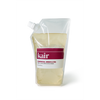How to get rid of clothes moths
We’re in the midst of moth season, which usually lasts until the end of October. Clothes moths have expensive taste, and are particularly fond of natural fibres such as cashmere, wool, silk and cotton. They’re snuggly and warm, after all - a perfect moth breeding ground. It's not such good news for your clothes though: moth eggs can cause catastrophic damage to these natural fibres. But there are several ways to keep the moths at bay. Here are our top tips for keeping your clothes - and carpets - moth-free...
Keep your spaces clean and dry
Prevention is always better than cure, so try to avoid attracting moths in the first place. Moths love worn clothes, and are attracted to sweat and food stains, so always keep your clothes clean, and wash them especially thoroughly before you put them away. For the same reason, give all your wardrobes and cupboards a regular deep clean, hoover and wipe down, so that there aren’t any dusty corners for them to lurk in (use the crevice tool on your vacuum cleaner when targeting the corners and edges). Be sure to also air these spaces regularly and keep them as well-ventilated as you can, to prevent the build-up of warm, damp or musty conditions which moths thrive in.
Store away your clothes carefully
Take Kair when storing your clothes. If you’re putting them away until next autumn or winter, pop them in an airtight container or vacuum storage bag (we love this one from Lakeland). Be sure to avoid cardboard boxes, which larvae will simply chew through. Also avoid letting cedarwood blocks or chips come into direct contact with your clothes, as these can transfer oil onto the fabrics and stain them. Instead, wash with our Wool, Silk and Delicates Wash - the cedarwood, amber and iris scent is a natural moth repellent.
Use a natural moth repellent
You can also use our Signature Cedarwood Finishing Spray as a natural moth repellent. Simply spritz away and infuse with aromatic fragrance. Other sweet-scented deterrents include hanging sachets of lavender, rosemary or clove (we love these ones from Thought). Put them in your wardrobe and drawers to keep those moths at bay!
Spot the signs
The very presence of moths inside is a warning sign - if any lay their eggs in your home, their larvae will feast on your natural fibres once those eggs hatch. Be on the lookout for the brown house moth (8mm long, with bronze, black-flecked wings) and common clothes moth (6-7mm long, with paler, beige wings) in particular. These have a taste for animal fibres like cashmere, wool, silk and angora, but will also readily chomp on cotton if there’s nothing else available. The next step is to check for eggs: creamy white larvae with a brown head are a sure indication. Check dark, undisturbed places in particular, such as at the back of your wardrobe or a corner of your chest of drawers, or underneath rugs and behind furniture. Moths aren’t just drawn to light, but seek out darkness to lay their eggs. Even if you remain vigilant with your moth-checking, moths might find their way to your clothes: you’ll know by those tell-tale holes in your favourite cashmere jumper or silk scarf. Clothes moths will also make a meal out of soft furnishings such as wool carpets, and can leave these with unsightly bald patches, so be sure to check your carpets too.
Break the cycle
If you spot signs of moths, don’t panic! You will need to stop the life cycle, which means removing any unhatched eggs as well as larvae. Begin by washing your clothes and then sealing your moth-ridden pieces away into disposable airtight bags (like these ones from John Lewis) and storing them in a freezer, for either a day or overnight. Be sure to give all exposed areas like wardrobes and drawers a thorough clean, as well as your washing machine. You can also use a special ‘moth box’ (like this one from Cashmere & Cotton), which attracts male moths by releasing the female pheromone and then trapping them on a sticky board. These boxes are also effective at monitoring the scale of an infestation.
Make do and mend
There’s no need to cast aside your moth-eaten knitwear. Brush up on your needlework, and make what was holey whole once more. You can go old-school and try out darning, or if your pieces have lots of little holes in them, opt for needle felting. For single, large holes, you can also simply sew a patch over the top using scraps of fabric or ready-made iron-on patches like these. Keep the threads and yarns which come with your garments in a safe place for any future repairs.
Cover image by Getty Images


















